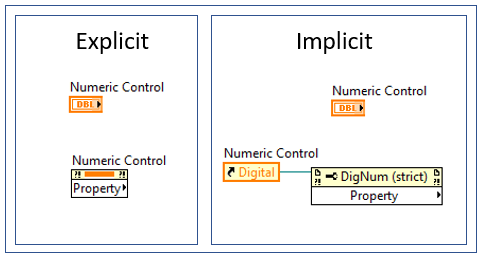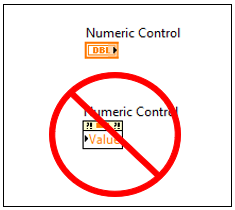Property node: Difference between revisions
No edit summary |
m Clarify performance considerations |
||
| Line 9: | Line 9: | ||
Clicking on the Property, you can choose what Property you want to '''Read/Write'''. You choose if the Property Node is '''Read''' or '''Write''' by right-clicking on the Property Node selecting '''Change to Read''' or '''Change to Write'''. By default, the Property Node is set to '''Read'''. | Clicking on the Property, you can choose what Property you want to '''Read/Write'''. You choose if the Property Node is '''Read''' or '''Write''' by right-clicking on the Property Node selecting '''Change to Read''' or '''Change to Write'''. By default, the Property Node is set to '''Read'''. | ||
==Performance | ==Performance considerations== | ||
'''Property Nodes''' | '''Property Nodes''' of user interface objects can have a significant performance impact. That's because their execution is serialized with other operations in the UI thread. Using '''Property Nodes''' indiscriminately therefore slows down execution because the Block Diagram waits while these properties execute in the UI thread. Many properties also force a VI's front panel to be loaded into memory. This increases overall load time and memory footprint. | ||
==Best practices== | |||
Use local variables instead of the '''Value''' properties when accessing user interface objects in the same VI. | |||
[[File:Captura de tela 2023-08-06 002028.png]] | [[File:Captura de tela 2023-08-06 002028.png]] | ||
Revision as of 08:03, 6 August 2023
| Object information | |
|---|---|
| Owning palette(s) | Application Control palette |
| Type | Function |
| Requires | Basic Development Environment |
| Icon |  |
Property Nodes are nodes that you can use in your Block Diagram to GET or SET properties on a local or remote application, VIs, and objects. Property Nodes allow you to programmatically control the properties of a Front Panel object, for example: color, visibility, position, behavior, etc.
You can use Property Nodes in two ways: Explicit that you choose what the Control/Indicator it referees to, or Implicit that is the case when you use a Reference wired to the Property Node that indicates what is LabVIEW item you referee.
Clicking on the Property, you can choose what Property you want to Read/Write. You choose if the Property Node is Read or Write by right-clicking on the Property Node selecting Change to Read or Change to Write. By default, the Property Node is set to Read.
Performance considerations
Property Nodes of user interface objects can have a significant performance impact. That's because their execution is serialized with other operations in the UI thread. Using Property Nodes indiscriminately therefore slows down execution because the Block Diagram waits while these properties execute in the UI thread. Many properties also force a VI's front panel to be loaded into memory. This increases overall load time and memory footprint.
Best practices
Use local variables instead of the Value properties when accessing user interface objects in the same VI.


